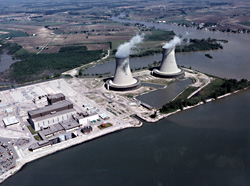Proof enough: Thyroid abnormalities in children after Fukushima
 Following the recent discovery that 36% of nearly 40,000 Fukushima children examined have abnormal thyroid growths, the inevitable industry apologists have surfaced, questioning any connection between the radioactive iodine spewed out when three cores at Fukushima began melting in March 2011. But the burden of proving safety should be on those whose profit results in poisoning, not on those who are poisoned. So says the precautionary principle, which does not require certainty of harm to halt radiation exposure.
Following the recent discovery that 36% of nearly 40,000 Fukushima children examined have abnormal thyroid growths, the inevitable industry apologists have surfaced, questioning any connection between the radioactive iodine spewed out when three cores at Fukushima began melting in March 2011. But the burden of proving safety should be on those whose profit results in poisoning, not on those who are poisoned. So says the precautionary principle, which does not require certainty of harm to halt radiation exposure.
What is known about thyroid disease, radioactive iodine exposure and children?
Certainly radioactive iodine is a cause of thyroid irregularities, often cancer, as industry proponents admit and studies at Chernobyl illustrate. Radioactive iodine can be inhaled or ingested.
Dr. Yamashita, known as “Mr. 100 mSv” in Japan and a proponent of a 20 mSv limit for children (the same as the German nuclear worker exposure limit), conducted a study of Nagasaki, Japan children in 2001. In this study 0-0.8 percent of children had nodules—much lower than the Fukushima children -- a population that could be similar and therefore act as a control group.
In general, children are more susceptible to radiation exposure.
Studies show that thyroid abnormalities have not appeared this quickly in past radioactive iodine exposures, but that does not mean it can’t happen.
What are the difficulties in assessing exposure to radioactive iodine?
The Tokonami study recently estimated doses from Fukushima radioactive iodine in part by using measured levels of radioactivity in the thyroid of 62 people. Tokonami claims that the median estimated dose is 4.2 milllisieverts and futher, claims that most of the dose came from inhalation, not ingestion. However, this study also claims that the doses from Chernobyl were much higher. The results of this study are incomplete for several reasons and should not be used to inform the data on thyroid abnormalities in children.
Although it is tempting to compare iodine exposures from one circumstance to another, exposure scenarios can be very different. Health effects should be examined on their own merit, beginning with the diagnosis of an abnormality, since variations in exposure and individual susceptibilities can make reliance on previous exposure scenarios misleading.
Starting a health study like Tokonami with an assumed dose (which is an estimation), instead of an examination of health impacts (which are real), is unwarranted because of the uncertainty in dose estimation. The 36% of thyroid abnormalities in children do exist and had to come from somewhere (quickly). Even if dose estimates are thought too low to cause them, there still has to be an explanation.
At Fukushima the official position was that milk consumption was restricted in the days following the accident but not after Chernobyl -- this means that people in Japan got less iodine dose. But it is less clear that those in the Fukushima area did not eat iodine rich foods like seaweed and shellfish that could result in greater exposures.
At Chernobyl, many kinds of radioactive iodine were examined whereas at Fukushima, doses from iodine 131 are the main focus so far since assessing dose for other iodines would be time-consuming. Since there is a good chance that the population was exposed to other radioactive iodines, exposure levels could be higher than measured or estimated.
The population of Japan has a diet high in iodine while that of former Soviet states exposed to Chernobyl radiation is iodine deficient. This was thought to have conferred a protective effect on Japan’s population, but the Fukushima children data casts doubt on this.
In general, studies from Chernobyl seem to account for all damage from iodine 131 (including the beta radiation, not just gamma) while it is unclear that the Fukushima assessment has accounted for beta damage. Since most of the dose to the thyroid from internal iodine contamination comes from beta, leaving it out would underestimate doses to Japanese children.
Clarifying methodologies and making them public is one way to address the public concern over exposure to radioactivity. Determining exposure is a complex process based a great deal on assumptions and estimates. Current lack of clarity, on beta dose from iodine, on assumptions made, methodologies used and the reasons why, only adds to the confusion and mistrust. To state that the radioactive iodine doses at Fukushima were many times lower than those at Chernobyl is completely unwarranted at this point given the uncertainties outlined above. The study would have been more valid if this comparison had been left out.
The Take-Away Points
It is reasonable to conclude, in the face of the evidence and even considering all of the uncertainties, that children could have an increase in thyroid abnormalities like cysts and nodules, due to radioactive iodine exposure from Fukushima.
While radiation is not known for certain to be the cause in all cases, according to the precautionary approach this link doesn’t have to be absolutely proven for reasonable people to act to stop exposure or to blame radiation.
And, if the thyroid abnormalities were NOT caused by radioactive iodine, then WHAT was the cause of the abnormalities? Radiation cannot be absolved without a viable alternative cause presented. Again, The 36% of thyroid abnormalities in children do exist and had to come from somewhere.





 August 8, 2012
August 8, 2012